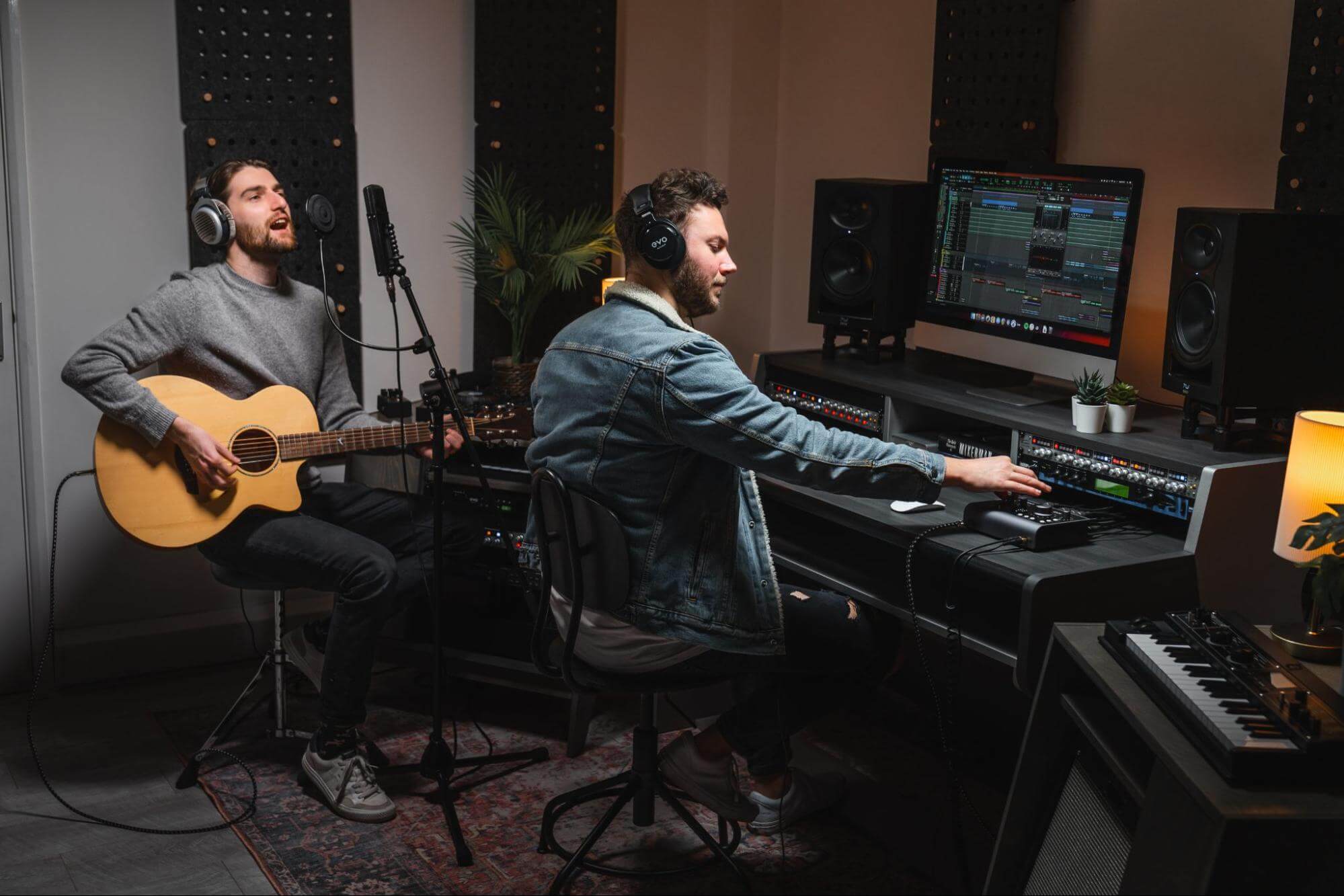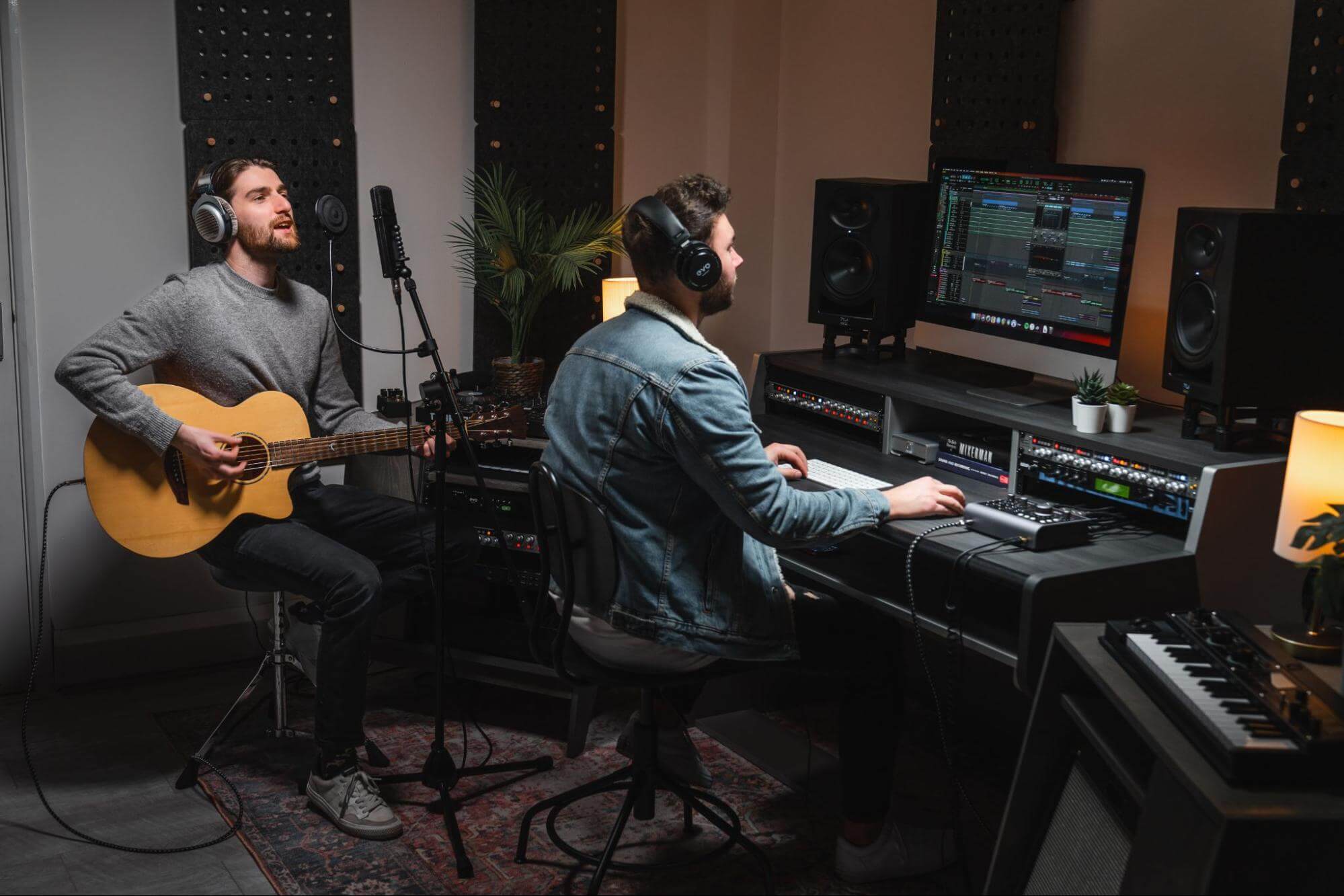Intro
Live gigs – anyone remember these??

© Copyright Matt Birch Pictures 2014
Whether playing to an arena of 100,000 people or making an appearance at a local grassroots venue, I go through pretty similar processes when getting gig ready. A gig’s a gig right, and as an artist, the care, attention and sweat you put into a show isn’t dictated by its size. And, as players will often tell you, the experience and ground level exhilaration of a high-octane sardine-box show to 100 people in a battered and bruised back room can often be much more fulfilling than those of a state of the art stadium and all its excess. So, first off the block, put the same passion into every show you play and you do that by believing it might be your last. And in times like these, it seems that could be all too true…
For me, getting gig ready fundamentally falls into three main categories: your gear, the set, and the soundcheck.
While we’ve established that all gigs are equal, at least emotionally, different shows do undoubtedly require different gear choices in terms of guitars, amps and pedals…
Amps
Amps
That vintage Marshall Super 100 watt with 4×12 cab may conjure up the elemental voodoo spirit of Hendrix when it’s cranked, but the reality for most musicians is that they don’t get many gigs that warrant such formidable power from an amp. Jimi, and Jimmy, both needed earth-moving sonic bulldozers like these live because back in their heyday, guitarists didn’t get to go through the PA. The systems just weren’t that great then and had to be put to task getting the vocal and drums across to the audience. Plus Jimmy had John Bonham to contend with! Super-loud amps were the only way to get your guitar to fill the hall/hippie-filled field. That and of course the fact that they do sound frickin awesome when dialled to ear bleed! But it ain’t 1970 anymore – you have to wear a seatbelt in a car, you can’t smoke on airplanes and we now know that tinnitus is a very real concern for rockers. The reality of the 21st century is that, with perhaps the exception of festivals, most shows require, even demand, much less sheer power from an amp.
Probably not the ideal choice of amp for the 100 Club but the man from Marshall wouldn’t have it any other way…

© Copyright Peter Stevens Photography 2015
The truth of the matter is that these are not the amps that the rock giants of old used in the studio either. Zeppelin 1 to 4 and most of The Who’s back catalog were recorded on much lower wattage amps dialled to break up and beyond, further fuelled with tone bending fuzz where necessary. Most acts playing live today choose to have things quieter on stage and use the capacity of the modern PA to deliver the sound, which the engineer can then mix properly rather than having to follow the ever increasing guitar volume onstage – well, they still have to do that in reality! But hey, the cover of Neil Young’s “Rust” would look pretty rubbish if he’d listened to all this! The lesson here is – if you have the choice, use an amp that suits the size of the venue. If you need your amp to be on the edge of break up to get ‘your sound’, go for something with a lower wattage that you can crank to bite just right without blowing anyone off the stage. Don’t try getting your 100 watt Fender Blackface to do it – it’s just not going to happen. And your ears are pretty essential in this game. Alternatively, if you don’t have the option, use that Fender set clean (probably on notch 1 max!) and use a pedal to give you the sound of a breaking-up amp. There’s an incredible range of pedals out there to suit every sonic taste. Lastly regarding amps, in an ideal world, you’ll have a backup amp in case yours goes down, or at least backup tubes (if you know how to replace them), but admittedly for most this is not a practical option.
Guitars
Guitars
As a musician, I try to play with as wide a range of other musicians and expose myself to as many different styles as possible – it’s how you get better, pick up tricks n licks and expand your musical horizon and vocabulary. While you can work with any, different guitars do lend themselves to different styles. Personally, my three main electrics are a 72 Fender Telecaster, a 64 Gibson SG and a modern Fender Stratocaster. The Tele is certainly my workhorse and my go-to axe for most scenarios – I just love its simplicity – but if I want to deliver a thicker, more hefty rock sound then I’ll turn to the bite of the P90s on the SG, which just sound so powerful. The cleans on the Strat are something else again, plus it’s 80% more reliable than a 40 or 50 year old guitar! The point here is, again if you have the option, try to use a guitar with a sound which suits the style.
Gig ready in guitar world
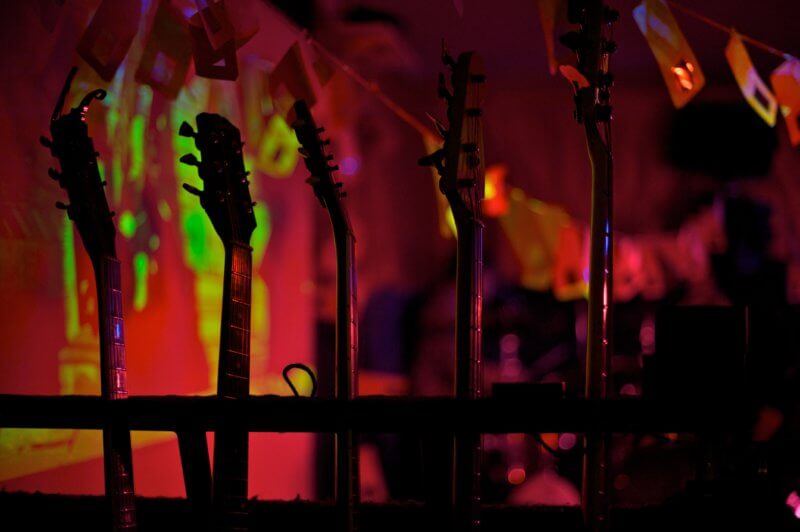
© Copyright Christopher Scholey
Try to always have at least one back-up guitar with you at a gig. For bigger shows, with a road crew, I will take several, ready n’ set on the side of the stage, tuned with capos/alt tunings where needed for smooth transitions between songs, but even for small shows it’s much better to have a spare than to have the audience wait while you have to restring after breaking that string mid solo. This is particularly true if you break a string halfway through a song – you can usually get back in within 15 seconds as opposed to a good 2 minute (which feels like 20) string wind. Strings break, so be ready.
Pedals
Pedals
Watch out, here’s the rabbit hole! If you are anything like me, these little boxes of sonic magic may have become something of an addiction! I love messing around with sound, conjuring up the aural sorcery that different combinations and dial tweaks can create. BUT the focus for any guitarist should always be their playing. Jeff Beck can make a guitar that has been sat growing dusty in Save The Children for 30 years sound great without any supplementary electronic assistance – while he is also a master of effects, he certainly doesn’t rely on them, but rather exploits them to his playing’s advantage. That said, he is of course one of a rare breed!
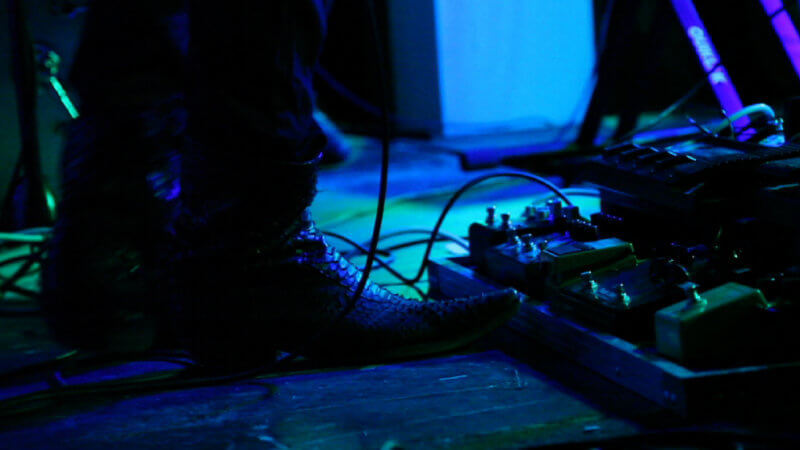
The other thing to consider here is that if you are having to step on three or four pedals every 30 seconds during a song, it can only detract from your playing. Keep things as simple as possible. If you need lots of pedals, and therefore presumably lots of changes, then do definitely look into guitar switching solutions which can really make the most complicated of pedal changes very simple at the click of just one switch. The new G3 from the guys at Gig Rig is a fantastic option – available from www.thegigrig.com – or check out Disaster Area’s various smaller and more affordable options at www.disasterareaamps.com. Some switching systems can however be large and will take up real estate on your pedalboard, which in turn will take up real estate on the stage so again, horses for courses – the size of the show (and its stage) will dictate all.

The Gig Rig G3
If like me you regularly play shows of varying sizes, you may end up having more than one pedalboard set up. If you do have just the one board which you change to suit each show, then be sure to test all the connections in rehearsals. There’s nothing worse than a complicated pedalboard set up going down during a live gig – it’s not something that is easily resolved in the heat of the moment – it’s not the drugs that send musicians mad, it’s the wires!
Another reason to keep things as simple as possible! Some people opt for multi-fx boards to overcome these sorts of complications, but personally I have never found one which sounds anywhere near as good as individual pedals do. However, there’s a lot to be said for how comparatively simple they can make things.
Other Essentials
Other Essentials
Strings: people have differing opinions here, but I like to have fresh strings for a gig whenever possible. Make sure you play them in before the show though otherwise you’ll spend the whole gig tuning your guitar. Gently stretch the strings out after you have put them on the guitar and then give it a really good strum/play – all preferably done at least the night before the show to give them time to settle in. That way, after soundcheck and then warm up before the show, they should be sitting nicely and holding their pitch. Oh, and regardless of whether you take a spare guitar or not, definitely take spare strings!
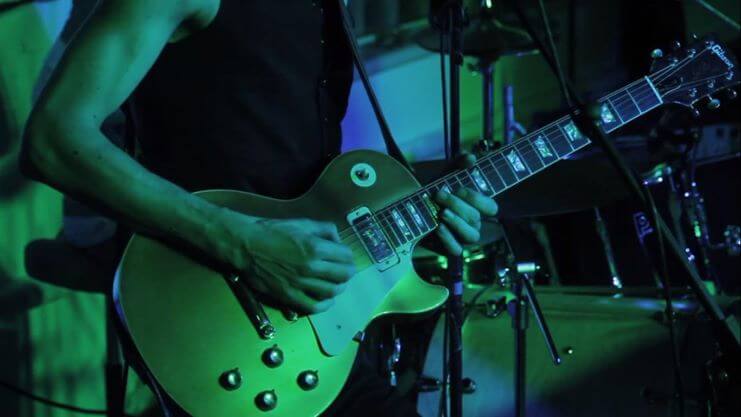
A quick note on tuning here as it’s amazing how many guitarists I come across don’t know this – when you tune a guitar string, always tune up to the note. If you go too far (sharp), then bring the pitch back down to below pitch (flat) and then bring it back up to pitch. This way the string and peg are held in tension and your guitar will stay in tune much longer than if you are dropping it down from sharp. Small things like this can make a big difference to a show – not only to how it sounds, but to how you enjoy it. The overriding thing with all your gear is to get it set before the gig so you don’t have to worry about it during the show. If you are using multiple tunings during a gig, I highly advise bringing extra guitars to have ready in the appropriate tunings, rather than trying to tune a guitar to dropped G for a track and then back to standard – that’s a sure-fire recipe for string breaking and out of tune guitars.
Oh and don’t forget picks – plenty of picks… always losing the damn things.
The Set
The Set
Integral to every show is of course the set. Personally, I can’t do without a setlist at a live show – it’s my musical rubric for the night. What’s coming when, what guitar to be playing, what tuning, what amp or effect tweaks might be needed in between songs – the list goes on. That’s not to say that the lead singer isn’t gonna totally change it all as soon as the horses bolt, but at least the markers are there. I go through a set list chronologically before a show and mark it up with any guitar/amp/pedal changes, tracks that need capos or different tunings, so that it’s as easy as possible when the show is up and I get to that moment. Walking it through in your head beforehand also avoids any impossible changes. Some of the bands I have played in like to leave only a few seconds between songs and that may just not possible if you are playing the coda to one then straight into the intro to another on another guitar in a different tuning.
The other great thing of having a setlist in advance is you can practice it. You should be playing as many hours a day as you can anyway, and running through a setlist in advance of a show is an ideal way of tidying up any moments that might be a little loose. It seriously pays dividends and will ultimately make you better prepared to go off-piste if the situation warrants it. And of course, the art of crafting the ultimate killer set is a thing that can only evolve through live shows – through understanding the live dynamics of that classic tune that you recorded over lockdown, but which has never seen a sweaty show before, for example. Seat of the pants is great, but the best sets I have ever been part of have all been pretty thought-out affairs, while also containing planned moments of total improvisation.
Soundcheck
Soundcheck
Soundchecks are vital. Getting the sound right onstage is going to massively affect your performance. If all you can hear is yourself, you ain’t gonna to be feeling the groove of the rhythm section or the vocal inflexions and directions of the singer. For me, in my monitors, I need kick, snare and lead vocals nice and loud – they are all my markers. Bass in too as the bedrock to the licks I’m laying down, but I tend to have most of my own guitar sound hit me from my amp (which is, of course, despite everything I’ve written earlier, as loud as anyone will let me take it!). I have a little of me in the monitor too, but find it can quickly overpower the rest of the mix if I have too much coming from there alongside the sonic force from my amp.
Soundcheck with Rotten Hill Gang
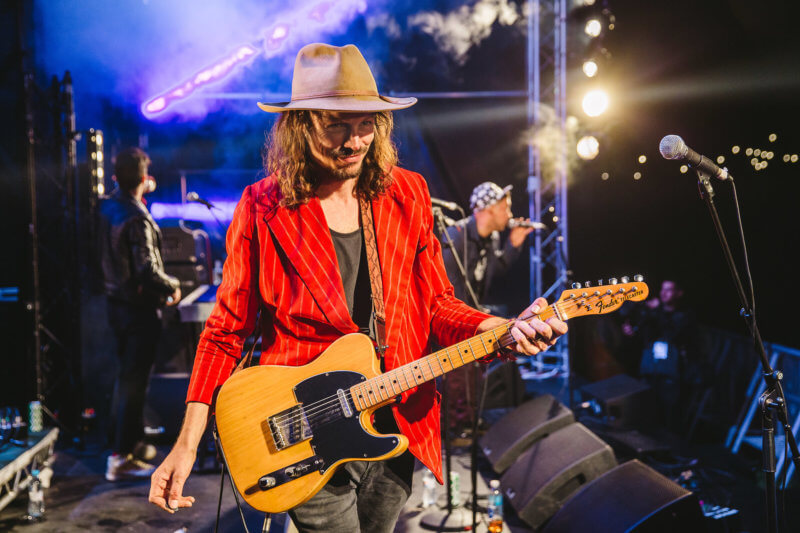
© Copyright Gobinder Jhitta 2017
Protect your ears whatever you do – without them you won’t be playing any gigs – and get the mix right accordingly. I am lucky enough to have silicon in-ear monitors which go a mile to protect you, but also require both a monitor engineer and set up, which you don’t get on the whole. I admittedly wouldn’t ever use standard over-the-counter ear protection during an actual gig, but would certainly in rehearsals.
After soundcheck, have a beer but not five, settle in, catch the support band, get in the vibe, warm up before getting onstage – and get out there and play from the heart! It might be the last time you ever play live…
![]()
About the author
After touring the world for seven years as lead guitarist for Razorlight, Gus has gone on to work with a variety of celebrated musicians including Mick Jones of The Clash, Phil Manzanera of Roxy Music, Paul Cook and Glen Matlock of The Sex Pistols, and reggae icons Max Romeo, Tapper Zukie and Dawn Penn, recording and filming with West London rap’n’roll collective Rotten Hill Gang.
Instagram/Facebook: @gusrobertsongtr
Twitter: @gusrobertsongtr
Our Products
-

2输入 | 2输出 音频接口
-

10输入 | 6输出 音频接口
-

6输入 | 4输出 音频接口
-

14输入 | 8输出 音频接口
-

10输入 | 14输出 音频接口
-

20输入 | 24输出 音频接口
-

24输入 | 32输出 音频接口
-

10输入 | 14输出 音频接口
-

10输入 | 4输出 音频接口
-

2输入 | 2输出 音频接口
-

4输入 | 4输出 音频接口
-

24输入 | 24输出 音频接口
-

开始录音所需的一切
-

8 通道智能前置放大器带 AD/DA
-

具有ADC的8通道麦克风前置放大器
-

具有 HMX 和 IRON 的 8 通道麦克风前置放大器
-

大型录音控制台
-

小型模拟录音控制台
-

小型模拟录音控制台
-

沉浸式音频接口与监听控制器
-

桌面监听控制器
-

环绕声控制器

